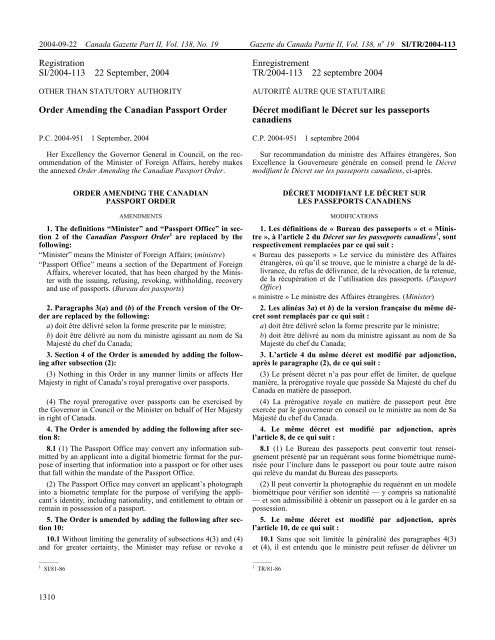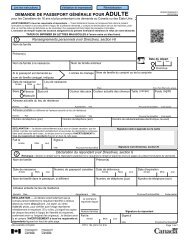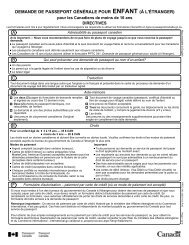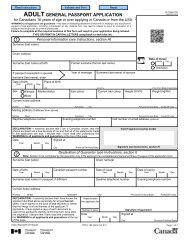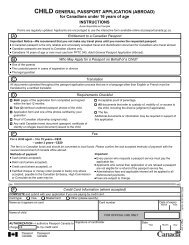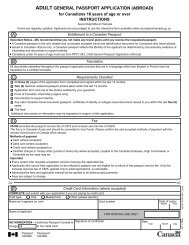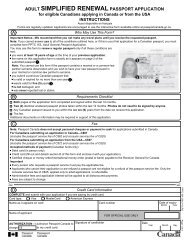Décret modifiant le Décret sur les passeports ... - Passport Canada
Décret modifiant le Décret sur les passeports ... - Passport Canada
Décret modifiant le Décret sur les passeports ... - Passport Canada
You also want an ePaper? Increase the reach of your titles
YUMPU automatically turns print PDFs into web optimized ePapers that Google loves.
2004-09-22 <strong>Canada</strong> Gazette Part II, Vol. 138, No. 19 Gazette du <strong>Canada</strong> Partie II, Vol. 138, n o 19 SI/TR/2004-113<br />
Registration Enregistrement<br />
SI/2004-113 22 September, 2004 TR/2004-113 22 septembre 2004<br />
OTHER THAN STATUTORY AUTHORITY AUTORITÉ AUTRE QUE STATUTAIRE<br />
Order Amending the Canadian <strong>Passport</strong> Order <strong>Décret</strong> <strong>modifiant</strong> <strong>le</strong> <strong>Décret</strong> <strong>sur</strong> <strong>le</strong>s <strong>passeports</strong><br />
canadiens<br />
P.C. 2004-951 1 September, 2004 C.P. 2004-951 1 septembre 2004<br />
Her Excel<strong>le</strong>ncy the Governor General in Council, on the recommendation<br />
of the Minister of Foreign Affairs, hereby makes<br />
the annexed Order Amending the Canadian <strong>Passport</strong> Order.<br />
1310<br />
ORDER AMENDING THE CANADIAN<br />
PASSPORT ORDER<br />
Sur recommandation du ministre des Affaires étrangères, Son<br />
Excel<strong>le</strong>nce la Gouverneure généra<strong>le</strong> en conseil prend <strong>le</strong> <strong>Décret</strong><br />
<strong>modifiant</strong> <strong>le</strong> <strong>Décret</strong> <strong>sur</strong> <strong>le</strong>s <strong>passeports</strong> canadiens, ci-après.<br />
DÉCRET MODIFIANT LE DÉCRET SUR<br />
LES PASSEPORTS CANADIENS<br />
AMENDMENTS MODIFICATIONS<br />
1. The definitions “Minister” and “<strong>Passport</strong> Office” in section<br />
2 of the Canadian <strong>Passport</strong> Order 1 are replaced by the<br />
following:<br />
“Minister” means the Minister of Foreign Affairs; (ministre)<br />
“<strong>Passport</strong> Office” means a section of the Department of Foreign<br />
Affairs, wherever located, that has been charged by the Minister<br />
with the issuing, refusing, revoking, withholding, recovery<br />
and use of passports. (Bureau des passports)<br />
2. Paragraphs 3(a) and (b) of the French version of the Order<br />
are replaced by the following:<br />
a) doit être délivré selon la forme prescrite par <strong>le</strong> ministre;<br />
b) doit être délivré au nom du ministre agissant au nom de Sa<br />
Majesté du chef du <strong>Canada</strong>;<br />
3. Section 4 of the Order is amended by adding the following<br />
after subsection (2):<br />
(3) Nothing in this Order in any manner limits or affects Her<br />
Majesty in right of <strong>Canada</strong>’s royal prerogative over passports.<br />
(4) The royal prerogative over passports can be exercised by<br />
the Governor in Council or the Minister on behalf of Her Majesty<br />
in right of <strong>Canada</strong>.<br />
4. The Order is amended by adding the following after section<br />
8:<br />
8.1 (1) The <strong>Passport</strong> Office may convert any information submitted<br />
by an applicant into a digital biometric format for the purpose<br />
of inserting that information into a passport or for other uses<br />
that fall within the mandate of the <strong>Passport</strong> Office.<br />
(2) The <strong>Passport</strong> Office may convert an applicant’s photograph<br />
into a biometric template for the purpose of verifying the applicant’s<br />
identity, including nationality, and entit<strong>le</strong>ment to obtain or<br />
remain in possession of a passport.<br />
5. The Order is amended by adding the following after section<br />
10:<br />
10.1 Without limiting the generality of subsections 4(3) and (4)<br />
and for greater certainty, the Minister may refuse or revoke a<br />
——— ———<br />
1 SI/81-86<br />
1 TR/81-86<br />
1. Les définitions de « Bureau des <strong>passeports</strong> » et « Minis-<br />
tre », à l’artic<strong>le</strong> 2 du <strong>Décret</strong> <strong>sur</strong> <strong>le</strong>s <strong>passeports</strong> canadiens 1 , sont<br />
respectivement remplacées par ce qui suit :<br />
« Bureau des <strong>passeports</strong> » Le service du ministère des Affaires<br />
étrangères, où qu’il se trouve, que <strong>le</strong> ministre a chargé de la délivrance,<br />
du refus de délivrance, de la révocation, de la retenue,<br />
de la récupération et de l’utilisation des <strong>passeports</strong>. (<strong>Passport</strong><br />
Office)<br />
« ministre » Le ministre des Affaires étrangères. (Minister)<br />
2. Les alinéas 3a) et b) de la version française du même décret<br />
sont remplacés par ce qui suit :<br />
a) doit être délivré selon la forme prescrite par <strong>le</strong> ministre;<br />
b) doit être délivré au nom du ministre agissant au nom de Sa<br />
Majesté du chef du <strong>Canada</strong>;<br />
3. L’artic<strong>le</strong> 4 du même décret est modifié par adjonction,<br />
après <strong>le</strong> paragraphe (2), de ce qui suit :<br />
(3) Le présent décret n’a pas pour effet de limiter, de quelque<br />
manière, la prérogative roya<strong>le</strong> que possède Sa Majesté du chef du<br />
<strong>Canada</strong> en matière de passeport.<br />
(4) La prérogative roya<strong>le</strong> en matière de passeport peut être<br />
exercée par <strong>le</strong> gouverneur en conseil ou <strong>le</strong> ministre au nom de Sa<br />
Majesté du chef du <strong>Canada</strong>.<br />
4. Le même décret est modifié par adjonction, après<br />
l’artic<strong>le</strong> 8, de ce qui suit :<br />
8.1 (1) Le Bureau des <strong>passeports</strong> peut convertir tout renseignement<br />
présenté par un requérant sous forme biométrique numérisée<br />
pour l’inclure dans <strong>le</strong> passeport ou pour toute autre raison<br />
qui relève du mandat du Bureau des <strong>passeports</strong>.<br />
(2) Il peut convertir la photographie du requérant en un modè<strong>le</strong><br />
biométrique pour vérifier son identité — y compris sa nationalité<br />
— et son admissibilité à obtenir un passeport ou à <strong>le</strong> garder en sa<br />
possession.<br />
5. Le même décret est modifié par adjonction, après<br />
l’artic<strong>le</strong> 10, de ce qui suit :<br />
10.1 Sans que soit limitée la généralité des paragraphes 4(3)<br />
et (4), il est entendu que <strong>le</strong> ministre peut refuser de délivrer un
2004-09-22 <strong>Canada</strong> Gazette Part II, Vol. 138, No. 19 Gazette du <strong>Canada</strong> Partie II, Vol. 138, n o 19 SI/TR/2004-113<br />
passport if the Minister is of the opinion that such action is necessary<br />
for the national security of <strong>Canada</strong> or another country.<br />
passeport ou en révoquer un s’il est d’avis que cela est nécessaire<br />
pour la sécurité nationa<strong>le</strong> du <strong>Canada</strong> ou d’un autre pays.<br />
EXPLANATORY NOTE NOTE EXPLICATIVE<br />
(This note is not part of the Order.) (La présente note ne fait pas partie du décret.)<br />
On April 27, 2004, a statement on the Government of <strong>Canada</strong>’s<br />
strategic framework and action plan for national security, entit<strong>le</strong>d<br />
Securing An Open Society: <strong>Canada</strong>’s National Security Policy,<br />
was made public by tabling it in the House of Commons and by<br />
issuing press re<strong>le</strong>ases from both the Minister of Justice and the<br />
Minister of Public Safety and Emergency Preparedness <strong>Canada</strong>.<br />
The national security policy is an integrated, comprehensive approach<br />
for en<strong>sur</strong>ing the safety of Canadians and for responding to<br />
emerging threats to national and international security. <strong>Canada</strong> is<br />
facing an increasingly comp<strong>le</strong>x and changing security environment,<br />
both domestically and internationally, underscored by<br />
growing threats of terrorism and organized criminal activity. One<br />
of the six major strategic areas requiring action to address those<br />
threats is border security, including using facial recognition biometric<br />
technology to enhance it. The passport program, which is<br />
part of <strong>Canada</strong>’s national security framework, must be adjusted to<br />
meet this evolving threat environment.<br />
Facial recognition is a key e<strong>le</strong>ment to preventing passport fraud<br />
and identity fraud and theft. It is an enhanced security mea<strong>sur</strong>e to<br />
combat transnational criminal and terrorist organizations which,<br />
as part of their modus operandi, misuse fraudu<strong>le</strong>ntly obtained<br />
travel documents to support their il<strong>le</strong>gal activities.<br />
Section 8.1 of the Order authorizes the <strong>Passport</strong> Office to convert<br />
a passport applicant’s photograph into a biometric template<br />
that would be used as part of the facial recognition program to<br />
confirm the applicant’s identity, including nationality, in order to<br />
determine their entit<strong>le</strong>ment to obtain and possess a Canadian<br />
passport. Furthermore, in accordance with passport security specifications<br />
established by the International Civil Aviation Organization<br />
for a globally interoperab<strong>le</strong> system governing the use of<br />
travel documents, the <strong>Passport</strong> Office will issue passports embedded<br />
with integrated circuit chips containing digital biometric information<br />
about the bearers.<br />
Section 8.1 of the Order clarifies the authority of the <strong>Passport</strong><br />
Office to convert the biographical data and facial image provided<br />
by a passport applicant into digital biometric format for insertion<br />
in the passport book<strong>le</strong>t. This would facilitate the travel of Canadian<br />
citizens abroad as immigration and border control agencies<br />
around the world will be ab<strong>le</strong> to effectively confirm a person’s<br />
identity and nationality, thus increasing the security of Canadian<br />
international travel<strong>le</strong>rs. It would also help to preserve the integrity<br />
of the Canadian passport and its international reputation as one of<br />
the most secure travel documents in the world. As well, this<br />
mea<strong>sur</strong>e would address two of the three core national security<br />
interests identified in the national security policy which are the<br />
protection of <strong>Canada</strong> and Canadians at home and abroad and contribution<br />
to international security.<br />
Section 10.1 of the Order confirms the existing authority of the<br />
Minister of Foreign Affairs — which can also be exercised by the<br />
Governor in Council, on behalf of Her Majesty in right of <strong>Canada</strong><br />
Le 27 avril 2004, <strong>le</strong> gouvernement du <strong>Canada</strong> déposait à la<br />
Chambre des communes son cadre stratégique et plan d’action<br />
intitulé Protéger une société ouverte : la politique canadienne de<br />
sécurité nationa<strong>le</strong> et annoncé par une série de communiqués publiés<br />
par <strong>le</strong> ministre de la Justice et la ministre de la Sécurité<br />
publique et Protection civi<strong>le</strong> <strong>Canada</strong>. La politique de sécurité<br />
nationa<strong>le</strong> établit une démarche cohérente et globa<strong>le</strong>, visant à garantir<br />
la sécurité des Canadiens et à contrer <strong>le</strong>s nouvel<strong>le</strong>s menaces<br />
à la sécurité nationa<strong>le</strong> et internationa<strong>le</strong>. Le <strong>Canada</strong> évolue dans un<br />
monde où <strong>le</strong> cadre de sécurité est de plus en plus comp<strong>le</strong>xe et<br />
changeant et où la menace terroriste et <strong>le</strong>s activités criminel<strong>le</strong>s<br />
organisées s’intensifient sans cesse, tant au plan national<br />
qu’international. Le renforcement de la sécurité des frontières,<br />
notamment à l’aide de la technologie biométrique de reconnaissance<br />
facia<strong>le</strong>, est l’un des six secteurs d’importance stratégique<br />
où des me<strong>sur</strong>es doivent être prises. Le programme de <strong>passeports</strong><br />
fait partie intégrante de la politique de sécurité nationa<strong>le</strong> et doit<br />
être adapté pour faire face aux menaces grandissantes.<br />
La reconnaissance facia<strong>le</strong> est un élément clé de la prévention<br />
des fraudes reliées aux <strong>passeports</strong> et de l’u<strong>sur</strong>pation et du vol<br />
d’identité. El<strong>le</strong> constitue une me<strong>sur</strong>e de sécurité améliorée pour<br />
combattre <strong>le</strong>s organisations criminel<strong>le</strong>s transnationa<strong>le</strong>s et <strong>le</strong>s<br />
groupes terroristes qui, dans <strong>le</strong> cadre de <strong>le</strong>ur opérations, utilisent<br />
des documents de voyage obtenus fraudu<strong>le</strong>usement pour mener à<br />
bien <strong>le</strong>urs activités illéga<strong>le</strong>s.<br />
L’artic<strong>le</strong> 8.1 du décret autorise <strong>le</strong> Bureau des <strong>passeports</strong> à<br />
convertir <strong>le</strong>s photographies des demandeurs de <strong>passeports</strong> en un<br />
modè<strong>le</strong> biométrique qui sera utilisé dans <strong>le</strong> cadre du programme<br />
de reconnaissance facia<strong>le</strong> pour vérifier l’identité des demandeurs<br />
de <strong>passeports</strong> — y compris <strong>le</strong>ur nationalité — et <strong>le</strong>ur admissibilité<br />
à obtenir un passeport et à <strong>le</strong> conserver. De plus, conformément<br />
aux normes de sécurité de <strong>passeports</strong> établies par l’Organisation<br />
de l’aviation civi<strong>le</strong> internationa<strong>le</strong> pour la mise <strong>sur</strong> pied d’un système<br />
inter-opérationnel mondial régissant l’utilisation des documents<br />
de voyage, <strong>le</strong> Bureau des <strong>passeports</strong> délivrera des <strong>passeports</strong><br />
avec un microcircuit intégré contenant <strong>le</strong>s renseignements<br />
biométriques numérisés relatifs aux titulaires de <strong>passeports</strong>.<br />
L’artic<strong>le</strong> 8.1 du décret précise que <strong>le</strong> Bureau des <strong>passeports</strong><br />
peut convertir <strong>le</strong>s renseignements biographiques et l’image facia<strong>le</strong><br />
fournis par <strong>le</strong>s demandeurs de <strong>passeports</strong> pour <strong>le</strong>s insérer sous<br />
forme biométrique numérisée dans <strong>le</strong> livret passeport. Cette technique<br />
facilitera <strong>le</strong>s voyages des Canadiens à l’étranger en permettant<br />
aux autorités de l’immigration et du contrô<strong>le</strong> frontalier du<br />
monde entier de confirmer <strong>le</strong>ur identité et nationalité, et, partant,<br />
d’accroître <strong>le</strong>ur sécurité. L’intégrité du passeport canadien et sa<br />
réputation internationa<strong>le</strong> comme l’un des documents de voyage<br />
<strong>le</strong>s plus sûrs du monde seront éga<strong>le</strong>ment préservées. De plus,<br />
cette me<strong>sur</strong>e répondrait à deux des trois objets fondamentaux de<br />
la politique en matière de sécurité nationa<strong>le</strong>, à savoir protéger <strong>le</strong><br />
<strong>Canada</strong> et <strong>le</strong>s Canadiens, au pays et à l’étranger, et contribuer à la<br />
sécurité internationa<strong>le</strong>.<br />
L’artic<strong>le</strong> 10.1 du décret confirme <strong>le</strong> pouvoir actuel du ministre<br />
des Affaires étrangères — qui peut éga<strong>le</strong>ment être exercé par <strong>le</strong><br />
gouverneur en conseil au nom de Sa Majesté du chef du <strong>Canada</strong><br />
1311
2004-09-22 <strong>Canada</strong> Gazette Part II, Vol. 138, No. 19 Gazette du <strong>Canada</strong> Partie II, Vol. 138, n o 19 SI/TR/2004-113<br />
— to refuse or revoke a passport in the interest of the national<br />
security of <strong>Canada</strong> or another country. The security of <strong>Canada</strong><br />
and foreign countries is a priority of the Government of <strong>Canada</strong> in<br />
its fight against transnational crime and terrorism which is illustrated<br />
by the continuing support of the Government of <strong>Canada</strong> to<br />
various international organizations, such as the United Nations,<br />
the G-8 and the International Civil Aviation Organization for their<br />
commitment to counter threats to our national security.<br />
Subsections 4(3) and (4) of the Order specify that the Order<br />
does not abolish the Crown prerogative over passports nor limit<br />
any discretionary authority of Her Majesty over passports, such as<br />
refusing or revoking a passport on grounds other than those listed<br />
in sections 9 to 10.1 of the Order.<br />
Finally, the definitions “Minister” and “<strong>Passport</strong> Office” are<br />
amended to refer to the appropriate designation of the Minister<br />
and the Department. The amendment to the latter definition also<br />
clarifies that the authority of the <strong>Passport</strong> Office to issue passports<br />
includes that of refusing to issue them as well.<br />
1312<br />
— de refuser ou de révoquer un passeport dans l’intérêt de la<br />
sécurité nationa<strong>le</strong> du <strong>Canada</strong> ou de pays étrangers, cel<strong>le</strong>-ci constituant<br />
une priorité du gouvernement du <strong>Canada</strong> dans sa lutte<br />
contre <strong>le</strong> crime transfrontalier et <strong>le</strong> terrorisme. Cette priorité est<br />
illustrée par l’appui continu du gouvernement du <strong>Canada</strong> aux<br />
différentes organisations internationa<strong>le</strong>s, tel<strong>le</strong>s que <strong>le</strong>s Nations<br />
Unies, <strong>le</strong> G-8 et l’Organisation de l’aviation civi<strong>le</strong> internationa<strong>le</strong>,<br />
dans <strong>le</strong>ur engagement à combattre <strong>le</strong>s menaces à notre sécurité<br />
nationa<strong>le</strong>.<br />
Les paragraphes 4(3) et (4) précisent que <strong>le</strong> décret n’abolit pas<br />
la prérogative roya<strong>le</strong> en matière de passeport ni ne limite <strong>le</strong> pouvoir<br />
discrétionnaire de Sa Majesté du chef du <strong>Canada</strong> à cet égard,<br />
tel que <strong>le</strong> refus de délivrer un passeport ou la révocation de passe-<br />
ports pour des motifs autres que ceux énumérés aux artic<strong>le</strong>s 9<br />
à 10.1 du décret.<br />
Enfin, <strong>le</strong>s définitions de « ministre » et « Bureau des passe-<br />
ports » sont modifiées pour renvoyer aux désignations correctes<br />
du ministre et du ministère. La modification à la dernière définition<br />
clarifie éga<strong>le</strong>ment que <strong>le</strong> pouvoir du Bureau des <strong>passeports</strong><br />
de délivrer des <strong>passeports</strong> comprend aussi celui de refuser la délivrance.<br />
Published by the Queen’s Printer for <strong>Canada</strong>, 2004 Publié par l’Imprimeur de la Reine pour <strong>le</strong> <strong>Canada</strong>, 2004


